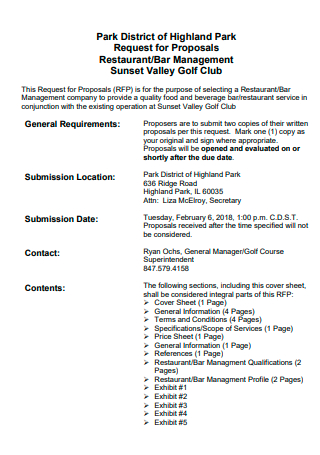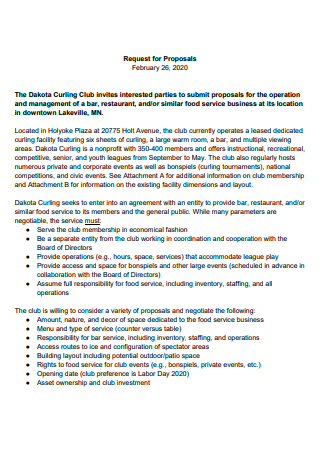10+ Sample Restaurant Management Proposal
-

Restaurant Management Services Proposal
download now -

Restaurant Bar Management Proposal
download now -

Restaurant Management Software Proposal
download now -

Restaurant Order Management Software Proposal
download now -

Draft Restaurant Management Proposal
download now -

Restaurant Noise Management Proposal
download now -

Course Restaurant Management Proposal
download now -

Restaurant Management Proposal in PDF
download now -

Restaurant Management and Operations Proposal
download now -

Beach Club Restaurant Management Proposal
download now -

Innovative Restaurant Management Proposal
download now
FREE Restaurant Management Proposal s to Download
10+ Sample Restaurant Management Proposal
What Is a Restaurant Management Proposal?
Qualities of a Good Manager
Tips for Writing a Proposal as a Manager
How to Write a Restaurant Management Proposal
FAQs
What are the three steps to the restaurant pattern of management?
What factors make a restaurant successful?
What is involved in restaurant management?
What Is a Restaurant Management Proposal?
Restaurant management integrates everyday operations with long-term growth by focusing on the profit margin. Restaurant managers may be in charge of balancing labor and product expenses, inventory management, restaurant marketing, and even restaurant troubleshooting. If you believe that the restaurant concept you have in mind will have eager customers waiting in line around the street, the first step in making it a reality is to write a proposal for a restaurant management system. Through a restaurant management system proposal, you can convince investors that your ideas are beneficial. Try your hand at writing one while using a restaurant business proposal sample as a reference.
Qualities of a Good Manager
It’s difficult to discover, maintain, and develop great people, but it’s even more difficult to find, keep, and develop excellent managers. With the advent of remote work and the demand for stronger personal qualities and improved staff assistance, what employees and employers anticipate of managers has evolved considerably in recent years. As new management styles arise, you must reconsider what you demand of managers and how well you can help them grow to their full potential.
Tips for Writing a Proposal as a Manager
It’s been said that you spend a certain percentage of your working life persuading others. Those you aim to persuade are frequently decision-makers outside of your team or corporation. They could be managers, executives, investors, or others with budget or decision-making authority. It’s critical to learn how to persuade management of your views if you want to have a genuine impact on the environment. The creation of a proposal is the first step in persuading management or any other stakeholder of an idea. The better your proposal is prepared, the more likely it is to be accepted by the decision-maker.
How to Write a Restaurant Management Proposal
Creating a management system that is more effective and efficient will be much appreciated by restaurant owners and employees. As they will value saving time while creating a more fun and workable environment you will notice an improvement in their actions. But to do that, you have to prepare a project proposal for a restaurant management system which this article will help you out with the guide below. Additionally, if you want references, you can view the provided proposal samples.
Step 1: Executive Summary
The executive summary’s purpose is to provide context for the rest of your restaurant management proposal by providing a high-level overview, or elevator pitch. Because it summarizes what’s in the remainder of the restaurant management proposal, entrepreneurs often finish the executive summary last. In the executive summary section, outline or draft your ideas. Give a comprehensive summary of your ideas, including a description of your restaurant’s main concept. While you don’t have to go into great detail, make sure your description is detailed enough to offer readers a general idea of the restaurant you are promoting.
Step 2: List of Services
For the next step, you will need to define the list of services you are offering for the restaurant. It is best to be as explicit as possible about the meals, services, and management you will offer, whether you will have a bar, whether you will provide catering, and whether you will have banquet facilities and accordingly hire appropriate staff to serve each station. Additionally, listing out your services will let higher-ups see how will you be able to manage each appropriate service that you offer.
Step 3: Market Analysis
You must know who your competitors are and where you fit in the market to be successful in business. In a market analysis, you will need to explain where your business fits in the market. You might incorporate the profiles or personalities of your ideal clients when describing your target market. The market analysis concludes with research, which examines the major trends in the sector and geographical area. You must mention your restaurant competition so that owners or investors can distinguish what you can bring to the table.
Step 4: Restaurant Management Strategies
Begin by determining your price points, such as the cost of food and beverage ingredients or menu items. The salaries of the employees, as well as how you compare to the competition. After you have established your products on the market, you should discuss the advertising techniques you are utilizing now and any excellent ideas you have for the future. Remember to mention your company’s website, as well as your search engine optimization strategy and any client loyalty programs. Concentrate on the features that will set you apart from the competition. In this area, mention competitor establishments by name to make your explanation more detailed and appealing.
Step 5: Financial Projections
Make a detailed cost breakdown. Find a potential restaurant site and consider the size of the facility, as both of these factors will have a significant impact on the restaurant’s operating costs. Make a list of the costs of running the restaurant, including rent, likely utilities like gas and electricity, food expenditures, and expected employee costs. While these numbers will be approximations, make them as exact as possible because the more accurate they are, the more relevant the data will be.
FAQs
What are the three steps to the restaurant pattern of management?
The first three phases would be determining expenses, making adjustments to fulfill targets, and predicting growth all fall into this category. The final three patterns include upholding operational standards, cultivating a positive workplace culture, and emphasizing customer service which is all part of daily operations management. Think of it as an additional measure and a restaurant business proposal.
What factors make a restaurant successful?
A strong restaurant identity, employing and maintaining workers, providing a friendly environment, becoming familiar with profit and loss statements, developing a profitable restaurant menu, and knowing how to advertise your best-selling products are just a few of the critical parts of a successful restaurant. But to have a successful restaurant, it is important to come up with management strategies that are strict but also possible to follow through.
What is involved in restaurant management?
A tip to manage employees is to make sure each of them has a task and a clear assignment of responsibilities and instructions. Disseminate each employee to have an assigned job such as servicing tables, dishwashing, table cleaning, kitchen cleaning, inventory management, food purchase, invoicing, and so on. You can elaborate further on that in the restaurant project proposal.
Writing a restaurant management system project proposal is considerably less confusing as you have gone through what you need to know in this very article. All the more, you have garnered additional knowledge useful when writing a proposal. With that being said, make sure to check out the samples and templates this site has provided to help you out as well.
